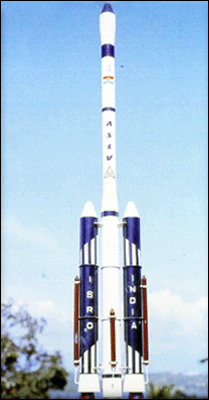ASLV
 The Augmented Satellite Launch Vehicle (ASLV) was intended to enhance the
payload capability to 150 kg, thrice that of SLV3, for Low Earth Orbits (LEO). While building
upon the experience gained from the SLV3 missions, ASLV proved to be a low cost intermediate
vehicle to demonstrate and validate critical technologies like strap-on technology, inertial
navigation, bulbous heat shield, vertical integration, closed loop guidance etc that would be
needed for the future launch vehicles. With a lift off weight of 40 ton, the 24 m tall ASLV was
configured as a five stage, all-solid propellant vehicle, with a payload capability of 150 kg
class satellites into 400 km circular orbits. The strap-on stage consisted of two identical
solid propellant motors of 1m diameter.
Four developmental flights were conducted under the ASLV programme. The first two developmental
flights which took place respectively on March 24, 1987 and July 13, 1988, could not succeed.
The third developmental flight, ASLV-D3 held on May 20, 1992, successfully placed SROSS-C
(weighing 106 kg) into an orbit of 255 x 430 km. ASLV-D4, launched on May 4, 1994, also turned
successful in placing SROSS-C2, weighing 106 kg, into the intended orbit. SROSS-C2 carried two
payloads, viz Gamma Ray Burst (GRB) Experiment and Retarding Potentio Analyser (RPA) and
functioned for seven years.
The Augmented Satellite Launch Vehicle (ASLV) was intended to enhance the
payload capability to 150 kg, thrice that of SLV3, for Low Earth Orbits (LEO). While building
upon the experience gained from the SLV3 missions, ASLV proved to be a low cost intermediate
vehicle to demonstrate and validate critical technologies like strap-on technology, inertial
navigation, bulbous heat shield, vertical integration, closed loop guidance etc that would be
needed for the future launch vehicles. With a lift off weight of 40 ton, the 24 m tall ASLV was
configured as a five stage, all-solid propellant vehicle, with a payload capability of 150 kg
class satellites into 400 km circular orbits. The strap-on stage consisted of two identical
solid propellant motors of 1m diameter.
Four developmental flights were conducted under the ASLV programme. The first two developmental
flights which took place respectively on March 24, 1987 and July 13, 1988, could not succeed.
The third developmental flight, ASLV-D3 held on May 20, 1992, successfully placed SROSS-C
(weighing 106 kg) into an orbit of 255 x 430 km. ASLV-D4, launched on May 4, 1994, also turned
successful in placing SROSS-C2, weighing 106 kg, into the intended orbit. SROSS-C2 carried two
payloads, viz Gamma Ray Burst (GRB) Experiment and Retarding Potentio Analyser (RPA) and
functioned for seven years.